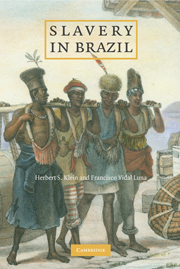9 - Freedmen in a Slave Society
Published online by Cambridge University Press: 05 June 2012
Summary
Every slave society in the Americas permitted slaves to be manumitted from the very beginning. All such regimes accepted the legitimacy of manumission, because it was the norm in Roman law and was deeply embedded in Christian piety and practice. A free colored class thus developed in every American slave society virtually from the first days of colonization. All such populations grew slowly in the sixteenth and seventeenth centuries and all faced some type of restriction on their freedom. These restrictions were uniquely applied to them because of their origin and color. From the early eighteenth century onward, however, Brazil began to distinguish itself from other slave regimes on the basis of its changing attitude toward the manumission process, which in turn caused major changes in the number and ratio of freedmen in the respective societies.
The differences in the numbers and acceptance of the free colored population in each of the American slave societies were determined by a broad spectrum of considerations, from religious and cultural to economic and social. In all cases, however, the minority of freedmen in the predominately slave societies faced hostility from their white neighbors and former masters, and in no society were both freedom and total acceptance a possibility. Racism was a part of every American system that held African slaves and did not disappear when blacks and mulattoes became free citizens and economic and social competitors.
- Type
- Chapter
- Information
- Slavery in Brazil , pp. 250 - 292Publisher: Cambridge University PressPrint publication year: 2009



